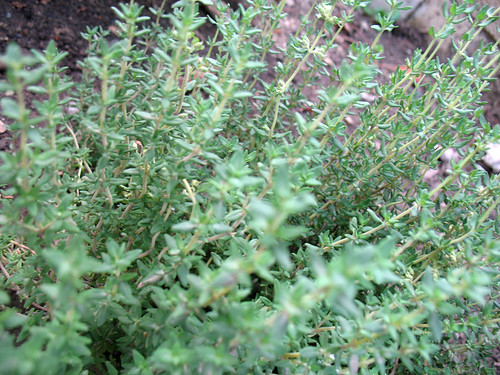Cropedia:Thyme
Thyme
" "
"
Source: http://www.flickr.com/photos/88951160@N00/1066243517/
Common Name: common thyme, garden thyme [4]
Scientific Name: Thymus vulgaris L. [4]
Years grown at UBC Farm/LFSOG: about 10 years
Growing conditions
Thyme is native to southern Europe, from Spain to Italy, and commonly cultivated in most mild-temp and subtropical climates. It is grown from seed, in light, dry calcareous soil, but can tolerate poor soils and drought once the plant is “established” [4]. During seedling establishment, beds should be always moist but not wet.
Thyme thrives in full sun, but tolerates partial shade. It grows best at temperatures from 7 to 20 degrees Celsius, and if soil pH is less than 5.5, agricultural lime should be added to the soil. It should be noted that nitrogen and fertilizers can increase yield, but weed control is hard [4].
Seasonality
Thyme is in season in summer, but also available all year, flowering in June [2]. In Spain, it is usually harvested during February to August.
Nutritional Information
| Nutrition Facts/Valeur Nutritive | |
|---|---|
| Serving Size: 100g (fresh) | |
| Amount Per Serving | %Daily Value* |
| Calories 101 | |
| Total Fat 2g | 0% |
| Saturated Fat 0g | 0% |
| Trans Fat 0g | |
| Cholesterol 0mg | 0% |
| Sodium 9mg | 0% |
| Total Carbohydrate 25g | 8% |
| Dietary Fiber 14g | 56% |
| Sugars 0g | |
| Protein 6g | |
| Vitamine A | 24% |
| Vitamine C | 266% |
| Calcium | 36% |
| Iron | 124% |
| * % Daily value based on a 2000 calorie diet | |
Information based on Canadian Nutrient File [3]
Thyme also has antioxidant and antimicrobial properties [4].
Recipes
Vegetarian Option
Blueberry peach fruit salad with thyme from Simply Recipes
- A perfect summer treat.
Zucchini with thyme from Simply Recipes
- A dish sautéed in butter and olive oil.
Additional usage inventory
Storage
- Thyme should be kept in the refrigerator for up to two weeks; its dark color will form as storage time increases [2].
Usage
Thyme has many uses, but mainly as seasoning in soups, fish, meat and poultry [2]. It has also been used in the following areas [4]:
- flavoring agent
- culinary herb
- herbal medicine
- processed for essential oil, extracts, oleoresins, dried leaves
- decorative herb used for culinary art
Thyme is primarily used when dried because fresh herbs have a very short shelf-life.
Academic connections
- coming soon...
References
- 1. Canadian Food Inspection Agency. (2010). Canadian food inspection agency. Retrieved from http://www.inspection.gc.ca/english/toce.shtml
- 2. CBS Interactive Inc. (2010) Thyme - Ingredient - CHOW Retrieved on March 25 2010 at http://www.chow.com/ingredients/228
- 3. Health Canada. (2010). Nutrient data. Retrieved from http://www.hc-sc.gc.ca/fn-an/nutrition/fiche-nutri-data/index-eng.php
- 4. Stahl-Biskup, E. et al. (2004) Chapter 19 Thyme. In Handbook of Herbs and Spices. Retrieved March 25, 2010 from CRCnetbase: www.crcnetbase.com